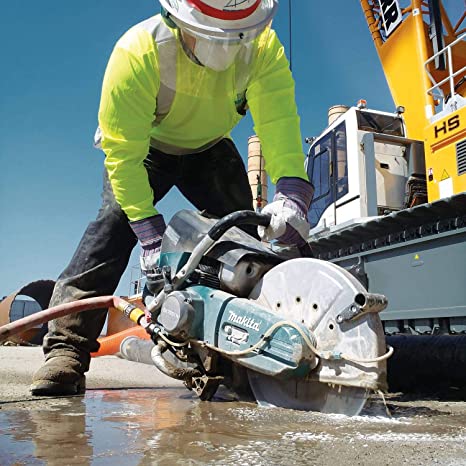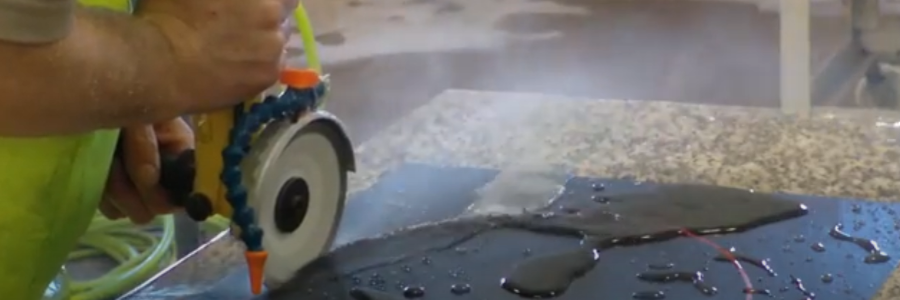Angle grinders have a versatile range of use cases including wood, metal, and masonry. When cutting wood or metal, the resulting sawdust or sparks generally settle quickly (although we recommend eye and respiratory protection for both).
However, masonry cutting jobs introduce a different type of debris. The silica dust from tile, concrete, and bricks is very dangerous and can cause a nasty host of issues. We implore you to use respirators when cutting masonry with any tools.
Wet Saws
There are a few specialty tools on the market for cutting masonry that incorporate a stream of water to cut down on free dust. Wetting the blade prevents recently freed dust particles from going airborne. It also keeps the blade cooler which prolongs blade life.
One example of these specialty tools are wet tile saws which are relatively inexpensive and do a great job cutting precise and clean lines in all types of tile. For larger tile jobs, we’d recommend picking up one of these. Most work by keeping the blade dipped into a water reservoir located in the base of the tool.

Another example is a heavy-duty cut-off saw commonly found in construction sites. These are more expensive and are made for grueling cutting applications in roads and foundations. Many of these include water connections that spray a controlled stream of water at the blade and concrete.

The key feature that keeps wet saws working is that the amount of water introduced to the blade and masonry is both controlled and stationary (relative to the blade).
Electricity and Water
Electricity and water don’t mix but the controlled nature of the water streams in wet saws prevent water from entering and disrupting the electrical bits in the tool.
Even so, it is possible to use a dry saw in the presence of water if you don’t have either of these specialty tools or want to use the angle grinder you already have on hand. It’s important to know that most dry saw manufacturers advise against using water with their products so warranties could be at risk.
How to Safely Use a Wet Saw
For dry saws converted into wet saws, there are a couple safety items to check. We recommend, if possible, to use a cordless tool. With no direct link to a power outlet, the chances of a life-threatening issue arising are brought to near-zero.
If a corded tool must be use, you have to use a GFCI outlet or extension cord.
You’ll see these in kitchens and bathrooms and other rooms that have both water and electricity service. They have internal circuit breakers that will trip in the presence of water or excessive power loads. By using a GFCI extension cord, you’ll keep yourself and your tool safe from the disastrous effects of water incursion into a powered system.
As with all power tools and especially when processing masonry, eye protection and a respirator is absolutely crucial. Wet saws significantly cut down on dust but they can’t eliminate silica dust completely.
We also recommend using a plastic sheet or tarp under your work area if cutting indoors since the dust will be turned to some degree of runny mud.
Angle Grinder Wet Conversion Kits
There are a couple ways to convert your angle grinder to a wet saw but we like this conversion kit. It quickly connects to your grinder and can fit several different sizes of blades.
The primary benefit to using a kit like this is that the water stream is both controlled and stationary relative to the blade. The risk of accidentally spraying the body or motor of the angle grinder is significantly reduced. Furthermore, this kit includes a coupling that attaches to a standard garden hose.
Which Blade is Best for Cutting Tile or Masonry?
There are different types of angle grinder blades but only a select few are meant for masonry. When cutting tile, we recommend a continuous rim blade. They will result in the cleanest and most controlled cuts. They also cut slower so the cooling effect of a water conversion kit will greatly lengthen the life of the blade.
Here’s our recommendation for a blade that works well under wet or dry conditions.
So, Can You Use Water with an Angle Grinder?
Absolutely! But not straight out of the box. With some accessories and a bit of knowledge on how to mitigate the risks, you can use an angle grinder with water to cut tile, brick, or any type of masonry to minimize dust and maximize blade life.




